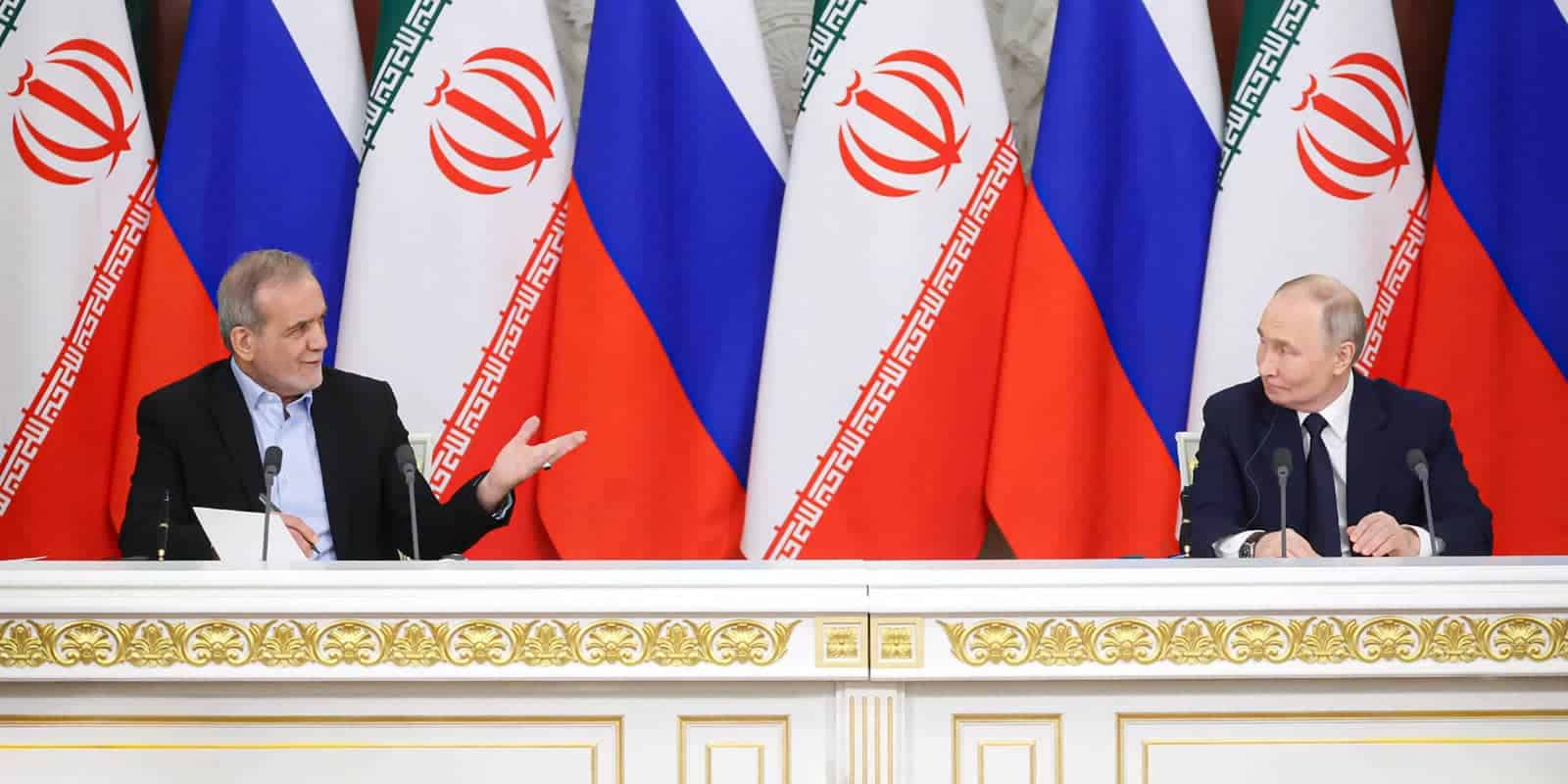Among the many directives that newly inaugurated US President Donald Trump issued during his first week in office —directives that stirred public opinion both at home and abroad —one received little attention. Though ostensibly concerned with national security, it was in fact no less revolutionary than the political and economic presidential directives issued alongside it.
This specific directive decrees the building of a defense system called “Iron Dome for America” to defend the United States against ballistic missiles, hypersonic missiles, advanced cruise missiles, and next-generation aerial threats.[1] Concurrently, the White House issued a fact sheet with additional details. [2] The fact sheet characterizes these weapons as “a catastrophic threat” to the United States. The directive noted that President Reagan endeavored during his term in office to deploy effective defense against nuclear attacks, but his plan was canceled before it could be realized. Subsequently, a limited national defense system was deployed against limited threats from rogue states and against rogue attacks only.[3]
The presidential directive is quite detailed and addresses all aspects of the issue, as follows
- The reference threats are, as mentioned above, ballistic missiles, cruise missiles, hypersonic missiles and advanced aerial threats. The directive does not explicitly refer to missiles carrying nuclear warheads.
- The sources of the threat are countries with capabilities equal to those of the U.S. (probably Russia and China), countries close to parity with the U.S. (probably North Korea), and “rogue states” (possibly Iran).[4] The directive states that these countries have already deployed defense systems on their territory against missiles and air threats.
- The operational requirements for the new system are: to protect the U.S. population, to protect the country’s critical infrastructure, and to protect its nuclear second-strike capability. The requirement is not limited to intercepting the threats in flight; it also includes preventing them from being launched.
- Means: The directive calls for accelerating the development of space-based warning and detection systems; developing space-based interceptors capable of intercepting hostile missiles during their boost phase; developing ground-based interceptors to protect valuable targets during both boost phase interceptions and atmospheric reentry phase interceptions; and developing capabilities to strike hostile missiles before they are launched. The directive also calls for developing non-kinetic interception capabilities (i.e., laser, and/or microwave-based systems).
- Protection of U.S. forces deployed overseas and protection of allies: The directive calls for a reexamination of the missile defense capabilities of U.S. forces deployed overseas, and for enhanced cooperation with allies and partner countries in the development, production, and supply of missile defense capabilities.
- Organization: The directive orders a review of the organizational structure and chain of authority and responsibility within the U.S. Department of Defense (and by implication, organizational changes) with the aim of implementing the directive as soon as possible.
Once the Pentagon began detailed preparation of a work plan, it changed the name of the project from “Iron Dome” to “Golden Dome” for two reasons: first, because the original name created the misleading impression that it was a procurement program of the earlier Israeli missile defense system of the same name; and second, because the name “Iron Dome” is already registered in the United States as a trademark owned by the Israeli company Rafael.[5]
In a speech to Congress on March 4, 2025, in which he reviewed the achievements of the first weeks of his presidency, President Trump added a few words of explanation: “As a first step [toward building the most powerful military force in history], I have asked Congress to approve a budget for the state-of-the-art “Golden Dome” defense system that will protect the homeland and will be entirely made in the United States.” He continued: “(President) Reagan wanted to do this a long time ago, but the necessary technologies were not available —far from it. But now we have these incredible technologies. Other countries have it, Israel has it, and the United States will have it too.”
As President Trump mentioned in both his presidential directive and his speech, this was not the first time that an American president has addressed the issue of protecting the United States from missile threats. Trump noted President Reagan’s 1983 “Strategic Defense Initiative”, but ignored President Nixon’s 1969 “Safeguard” program, under which the first American battery of anti-ICBM interceptors was deployed in North Dakota — and soon dismantled due to congressional opposition. The explanatory page for the “Iron Dome for America” initiative briefly mentions that a limited system for intercepting intercontinental ballistic missiles is already deployed in the United States but does so without naming it (“National Missile Defense”) or the president who ordered its establishment and deployment (Clinton, 1999).
This, then, is not the first but rather the fourth time in the past seventy years that an American president has initiated the establishment of a missile defense system on U.S. soil. Of the three previous initiatives, only one matured into an operational system: that of President Clinton, which was limited to defense against small-scale attacks by newly emerging nuclear wanabees, specifically North Korea, and which was implemented and deployed operationally (with 44 interceptors currently stationed in California and Alaska). President Nixon’s first system was deployed briefly but dismantled within months of its establishment, while President Reagan’s initiative was only marginally implemented.[6]
At the same time, an earlier initiative to defend the U.S. against airborne nuclear threats was fully implemented. During the height of the Cold War, the United States established a national defense system against nuclear bombers. This system, called the North American Aerospace Defense Command (NORAD), still exists today and includes a chain of giant early warning radars in the Arctic regions north of the United States, in the east coast of the United States, and in Great Britain. A command-and-control center was established in Colorado, linked to fighter jets tasked with intercepting hostile aircraft attempting to penetrate U.S. airspace. (Following the 9/11 terrorist attacks, the system was also authorized to warn against and engage hostile aircraft taking off from within the United States). NORAD is responsible for detecting and providing early warning of ballistic missiles aimed at U.S. territory as well at allied nations. It is expected to play a significant role in the “Golden Dome” initiative.
President Trump’s initiative is clearly modeled after President Reagan’s “Strategic Defense Initiative,” better known by its popular name of “Star Wars.” Like its model, the “Golden Dome” initiative is also concerned with protecting the entire territory and population of the United States against threats from countries with capabilities equal to those of the United States —now including China in addition to Russia —rather than the more limited threats posed by “rogue states.” Like Reagan’s initiative at the time, Trump’s decree also envisions space-based defense systems. Another point of similarity is the requirement to protect U.S. forces deployed abroad as well as American allies. Given the close parallels in aims and means, President Trump’s “Golden Dome” initiative merits the nickname “Star Wars II.”
Nevertheless, the two initiatives differ in several important aspects:
A. The Strategic rationale: President Reagan’s initiative was based on the idea of abandoning the strategy of “mutually assured destruction” as the foundation for global stability and instead adopting a policy of “no destruction” by rendering nuclear ballistic missiles “impotent and obsolete.” Critics argued that a defense-based strategy could work if and only if the proposed missile defense arrays could destroy every single hostile warhead — in military parlance this is referred to as “zero leakage.” Since such an absolute performance was deemed unattainable, the conclusion was that a defense-based strategy was doomed. Strategic stability and prevention of a nuclear world war, critics maintained, could only be achieved through a strategy of deterrence.
In contrast, Trump’s presidential directive states that the threatening countries already possess defense capabilities against missiles and air threats. This implies that the United States’ ability to deter them has already been impaired —while it lacks comparable defensive capabilities. The strategic logic of “Star Wars II” is therefore not to replace deterrence with defense, but to add a defensive layer to buttress deterrence. This rationale is clearly implied in Trump’s directive by the requirement that the “Golden Dome” defend U.S. second strike capabilities, in addition to defending its territory, population, armed forces and allies.
B. The operational rationale: Reagan’s “Star Wars” initiative which was purely defensive required that threats be intercepted in flight—that is, only after launch. The Trump initiative, by contrast, calls not only for interception but also threat prevention, by preempting impending hostile missile launches. This means the missiles must be attacked on the ground before launch (or at sea in the case of threats launched from ships or nuclear submarines). “Star Wars II” is therefore not a purely defensive, but a defensive-offensive initiative.
C. Threat scope: While President Reagan’ initiative focused solely on nuclear ballistic missiles, President Trump’s directive covers all categories of threat platforms, including aerial threats, ballistic missiles and hypersonic missiles. Moreover, the language of the directive is not limited to nuclear platforms. The directive covers all threat platforms regardless of the type of warheads they carry, including conventional ones. If this is indeed the intention of Trump’s directive, it signals a substantial shift in the U.S. threat perception, which until now has largely dismissed conventional threats to the homeland. This shift— if it is indeed embodied in the directive indeed may be informed by the lessons of the conflicts in the Middle East and Ukraine, where non-nuclear weapons have had concrete strategic effects, such as Iran’s conventional drone attack on Saudi oil facilities in September 2019 and Russia’s use of conventional ballistic and cruise missiles to destroy Ukraine’s electricity infrastructure.
Another significant difference concerns U.S. allies. President Reagan’s “Star Wars” initiative was not initially spelled out in the same level of details as Trump’s directive. Reagan’s objectives and methods developed over time, as the technological and political challenges became clearer. Initially, Reagan made no mention of the role of U.S. allies. However, strong opposition from many of them compelled him to invite their participation (including Israel) in the “Star Wars” initiative. In contrast, while Trump’s presidential directive calls for strengthening the defenses of U.S. allies, does not invite them to take part in the new initiative.
Reagan’s “Star War” was largely unrealized, except insofar as it concerned the defense of U.S. forces around the world and the protection of allies. The United States —then and now— is incapable of defending its own national territory against substantial ballistic and cruise missile attacks. The question, therefore, is why this remains the case, and what can be concluded from this state of affairs about the prospects for realizing “Star Wars II”
To be precise, President Reagan did not order the full-scale development and deployment of a missile defense system for the United States but rather initiated a research program that would examine the feasibility of such a system. As noted earlier, similar initiatives were pursued before Reagan’s time, most notably under President Nixon, which led to the practical development of the “Safeguard” system. That system relied on ground-based interceptors but could not guarantee the hermetic sealing of U.S. skies against Soviet nuclear missiles.
In the 1970s, scientists at the Lawrence Livermore National Laboratory formulated the concept of an enormously powerful X-ray laser. Studies and experiments were conducted that allegedly demonstrated the feasibility of placing such lasers in space, orbiting beyond the earth’s atmosphere, to intercept large numbers of Soviet nuclear warheads headed to the United States. This research program, dubbed “Project Excalibur,” was based on a nuclear explosion in space.[7] The director of the Lawrence Livermore Labs at the time was the renowned scientist Edward Teller, known as the father of the hydrogen bomb. In September 1982, Teller met with President Reagan and reportedly presented the idea to him. Six months later, Reagan announced to the nation a new initiative to defend U.S. territory against Soviet nuclear missiles. Although Reagan did not mention “Project Excalibur” by name, it is likely that this project and Teller’s assurances that it could be deployed in space within five years formed the background to the initiative.
President Reagan’s “Strategic Defense Initiative” faced a hostile reception from some American lawmakers as well as from most of the scientific community. Senator Ted Kennedy (brother of President John F. Kennedy) mockingly referred to it as “Project Star Wars” after the popular science fiction film released at the time. Ironically, this nickname was embraced by the American public and the wider world as praise rather than ridicule. Today, Reagan’s initiative is remembered by that name, while its official name title has been largely forgotten.
The research program within Reagan’s “Star Wars” initiative included not only nuclear X-ray lasers in space but also concepts for other weapons that bordered on science fiction, such as particle beams and powerful ground-based chemical lasers coupled with orbiting mirrors. The feasibility of most of these ideas, including “Project Excalibur” itself, was highly questionable. One of the more (relatively) realistic proposals was the “Brilliant Pebbles” concept, which envisioned placing a vast array of tiny satellites in space, each essentially functioning as a “space-to-space missile” designed to destroy hostile nuclear warheads by colliding with them. Thirty-five years later, this idea has been resurrected as part of President Trump’s “Golden Dome” initiative.
Reagan’s “Star Wars” initiative gradually faded after the fall of the Soviet Union in 1991. The primary reason for this was a perceived threat reduction: at the time, it seemed that the era of superpower confrontation had ended for good. The Russian Federation, while inheriting the Soviet Union’s nuclear arsenal, was not seen—at least by most analysts—as having inherited its aggressive global ambitions. There were however additional reasons for the demise of the “Star Wars” project: most of the weapon’s systems proposed in the initiative had questionable scientific and technological feasibility, while more practical systems required huge investments that were beyond even the United States’ financial reach.
The policy of the two subsequent Presidents — George Bush Sr. and Bill Clinton—was to wait until a concrete missile threat emerged from Third World countries while continuing research and technological programs that would expedite the timely development and deployment of defense systems if those threats materialized. The waiting period proved to be brief: in 1998, Iran conducted its first flight test of the Shahab 3 missile, while North Korea launched a satellite, which, though ultimately a failure, indicated the ability to develop missiles capable of hitting U.S. territory. In response, under pressure from a Republican-controlled Congress, Democratic President Bill Clinton was forced to launch the “National Missile Defense” program to protect the United States from limited missile attacks by rogue states.[8]
This program was implemented during the presidency of George W. Bush. Unlike the “Star Wars” initiative, the new program did not rely on exotic or experimental technologies of the “Star Wars” era but on established and proven systems, specifically ground-launched interceptor missiles. A massive interceptor missile bearing the somewhat pedestrian name of Ground Based Interceptor (GBI} was developed and 44 units were produced and deployed across the western United States—mostly in Alaska with a few in California— to defend the entire continental United States against North Korean missile threats. The system became operational in the early 2000s, although its success rate in interception tests was relatively low. The system is still operational at the time of writing.
The deployment of the system sparked bitter complaints from NATO allies who accused the United States of prioritizing its own defense, while neglecting that of its allies. To appease them, President Bush proposed a third GBI missile site in Europe. That decision met with furious opposition from Russian President Vladimir Putin and was later reversed by President Barack Obama.
As noted above, “Golden Dome” is the fourth in a series of initiatives since the 1960s aimed at defending the U.S. homeland against hostile missile threats. The previous three initiatives did not yield significant results; of them, only President Clinton’s limited initiative was fully implemented. What then are the chances that the new initiative will be more successful?
In his speech to Congress, President Trump attributed the failure of Reagan’s
“Star Wars” to technological immaturity. “The necessary technologies were not available” he said, but “now we have these unbelievable technologies.” In other words, what guarantees success today is the technological progress achieved since Reagan’s Presidency in the 1980s. The president did not specify which technologies he had in mind, but it stands to reason that what he was referring to breakthroughs in miniaturization, artificial intelligence and space launches. Of these, some of the most significant advances have been in the art—and cost—of delivering payloads to Earth orbit.
Trump’s “Star Wars II,” like Reagan’s 1980s initiative, relies on space-based interception, as this is the most cost-effective way to defend vast, continental sized areas. One of the most significant cost drivers in deploying weapons in space is the cost of launching them into Earth orbit. At the dawn of the space age, lifting a one-kilogram payload to low Earth orbit cost between $10,000 to $100,000. Placing a one-ton weapon in orbit would have cost between$10 million and $100 million—on top of the cost of the weapon itself.
Since then, launch costs for low Earth orbits have declined dramatically, mainly thanks to the pioneering breakthroughs of Elon Musk’s SpaceX company and other private satellite launch companies. Musk’s company currently offers launches into low Earth orbit at a cost of $1,400 per kilogram, about one-sixth of the lowest price during President Reagan’s “Star Wars” era. This trend is continuing, and the cost of launching one kilogram to low Earth orbit may drop below $100 in the coming decade.[9] The sharply reduced cost of lifting weapons into space may make them financially affordable.
One consequence of falling launch costs has been the recent emergence of commercial satellite constellations that cover the Earth in networks and offer customers persistent observation and reliable communication from any point on the planet to any other point. The most prominent of these is the Starlink satellite communications system, which currently consists of a dense network of approximately 7,000 small satellites orbiting the Earth. Starlink currently provides the Ukrainian military with communications that are resistant to Russian interference. The “Brilliant Pebbles” concept from the Reagan era, based on a constellation of hundreds or even thousands of space interceptors, was impractical at the time, in part due to prohibitive orbiting costs. Today, the concept appears far more feasible.
At the same time, the threats to U.S. territory have become more complex and sophisticated since the Reagan era. The threat Reagan confronted consisted solely of “classical” intercontinental ballistic missiles. Today, the threats listed in Trump’s presidential directive are far more advanced and diverse. Inter alia, they include hypersonic and cruise missiles that are far more difficult to intercept than “classical” missiles. President Trump’s operational requirements also extend well beyond Reagan’s, calling not only for threat interception but also threat prevention, probably by offensive means. In the ongoing contest between defense and offense, it remains unclear who will gain the upper hand, despite the many technological advances since Reagan’s time.
President Trump’s “Star Wars II” has not met the same level of hostility from the scientific community in the United States as President Reagan’s original initiative. However, the same liberal organizations and media outlets that opposed President Reagan’s “Star Wars” have published articles condemning Trump’s directive, using almost exactly the same arguments and language employed in the 1980s. “The call to establish an American Iron Dome is a fantasy,” declared the Union of Concerned Scientists, an organization that advocates for nuclear disarmament and has traditionally opposed missile defense.[10] The prestigious “Scientific American” magazine, another longstanding critic of missile defense programs, wrote that “the proposed program for space defense against hypersonic missiles is unnecessary, impractical, and would trigger a new and dangerous arms race”[11] —the very same arguments it employed to oppose Reagan’s “Star Wars” more than forty years ago, yet without the same fervor as in the past.
Somewhat surprisingly, and in contrast to the stormy response to Reagan’s initiative at the time, Trump’s “Star War II” has not elicited any response from Democratic members of Congress or from U.S. allies in NATO and elsewhere. Russia, however, issued an official condemnation of Trump’s initiative and accused the U.S. of planning to turn space into a battlefield.[12] However, the language was mild compared to the Soviet Union’s almost hysterical reaction to Reagan’s “Star Wars,” or the harsh rhetoric that President Putin has used in the past against the deployment of American missile defense systems in Europe.
The original name of Trump’s initiative—”Iron Dome for America” —was a compliment to Israel, acknowledging its success in defending the nation against rockets and missiles. At the same time, this expression of appreciation of Israel’s achievements should not be misread as an invitation to partner in the development of America’s missile shield. On the contrary, the president explicitly stated that the new systems would be manufactured exclusively in the United States.
The lessons that Israel (and the U.S.) have been and are learning from its multi-layered system are almost irrelevant to President Trump’s “Star Wars II.” Relative to the United States, Israel’s tiny territory—roughly the size of New Jersey — is practically a point target. Its small size comes with a strategic disadvantage: a lack of depth. But it also offers a distinct operational advantage. Defending a compact area like Israel is far simpler and cheaper than defending a vast country like the U.S. Israel can protect itself with small and relatively inexpensive interceptor missiles, whereas the United States requires large and costly systems such as the GBI missiles currently deployed in Alaska and California.
Moreover, space-based defense systems are of little relevance in Israel’s context. That said, one of the requirements of Trump’s presidential directive is to protect local national infrastructures. It is possible that for that purpose, the U.S. could use interceptor missiles designed in Israel, some of which are already partially manufactured in America.[13]
As noted, Trump’s presidential directive calls for cooperation with allies and partner countries in the development, production, and supply of missile defense capabilities. The use of the name “Iron Dome” in the directive, along with the mention of Israel as a model for emulation in the president’s address to Congress in early March, indicate goodwill toward Israel on his part. Still, as was the case with President Reagan’s original “Star Wars” initiative, it is likely that Israel will be excluded from “Star Wars II” programs aimed at defending U.S. territory. Nonetheless, Israel can be expected to continue to enjoy mutually beneficial cooperation with the U.S. in financial, technological, and military domains as it seeks to protect the country’s territory and its residents from missile threats of all kinds.
[1] The Iron Dome for America, Executive Order January 27, 2025
https://www.whitehouse.gov/presidential-actions/2025/01/the-iron-dome-for-america
[2] Fact Sheet: President Donald J. Trump Directs the Building of the Iron Dome Missile Defense Shield For
America. The White House, January 25, 2025
[3] “Rogue launch” refers to the unauthorized launch of a missile—not ordered by a legal command from a country’s legitimate government. During the first Cold War (1948-1990) the possibility and implications of rogue launch of nuclear missiles—whether due to malfunction, misunderstanding, or malicious action by local commanders—was discussed extensively within security organizations and strategic research institutes on both sides. The need to defend against “rogue launches” was one of the core operational requirements of the current U.S. National Missile Defense System.
[4]It is worth noting that France also possesses an arsenal of sea-based nuclear ballistic missiles with an intercontinental range, but it is likely that President Trump does not view this as a potential threat to the United States (at least at the present time).
[5]Judson, J. Iron Dome for America Gets a Golden Makeover, Defense News February 25, 2025
https://www.defensenews.com/pentagon/2025/02/25/iron-dome-for-america-gets-a-golden-makeover
[6] President Reagan’s initiative referred to two defensive requirements: one, defense of the homeland territory of the United States, and the second— protection of U.S. forces deployed abroad and of U.S. allies. While the first objective was never implemented— for reasons that will be discussed later—the second was substantially implemented. To protect U.S. forces around the world, two land-based systems were developed and deployed: THAAD and advanced versions of the Patriot missile defense system, as well as a naval system based on AEGIS ships and the “Standard 3” interceptor. For protection of allies, the Israeli “Arrow” system was developed —an advanced version of which was sold to Germany. All these systems participated in Israel’s defense against Iranian missile attacks during the Gaza War.
[7]The idea was to put a powerful nuclear bomb into orbit around the Earth, with disposable “laser cannons” attached to it. In the event of a Soviet nuclear attack, the device would maneuver so that each of its laser cannons was aimed at an incoming Soviet nuclear warhead. The detonation of the nuclear device would generate—albeit for a very brief time—X-ray beams of such intensity that they would destroy the targeted nuclear warheads before the cannons themselves were consumed by the explosion.
[8] Daalder, I.H. The Domestic Politics of National Missile Defense, Brookings July 10, 2000
https://www.brookings.edu/articles/the-domestic-politics-of-national-missile-defense/
[9]Graham G.E. How Much Does It Cost to Send 1 Kg to Low Earth Orbit, Medium December 18, 2020
[10] Grego, L. Calls For US Iron Dome “A Fantasy,” Union of Concerned Scientists January 28 2025 https://www.commondreams.org/newswire/calls-for-u-s-iron-dome-a-fantasy
[11] Vergano, D. Trump’s Iron Dome Space Weapons Plans Ignores Physics and Fiscal Reality, Scientific American February 19 2025 https://www.scientificamerican.com/article/trumps-iron-dome-space-weapons-plan-ignores-physics-and-fiscal-reality/
[12] Antonov, D. Russia Condemns Trump’s Missile Defense Shield Plan, Accuses The US of Plotting to Militarize Space, Reuters January 31 2025 https://www.reuters.com/world/russia-condemns-trump-missile-defence-shield-plan-accuses-us-plotting-militarise-2025-01-31/
[13] Sergie, M. Israel Missile Defense Maker Proposes System for US Shield, SEMAFOR February 21, 2025















Israel’s Veteran Peace Partners: The Role of Egypt and Jordan in the Context of Trump’s Gaza Plan